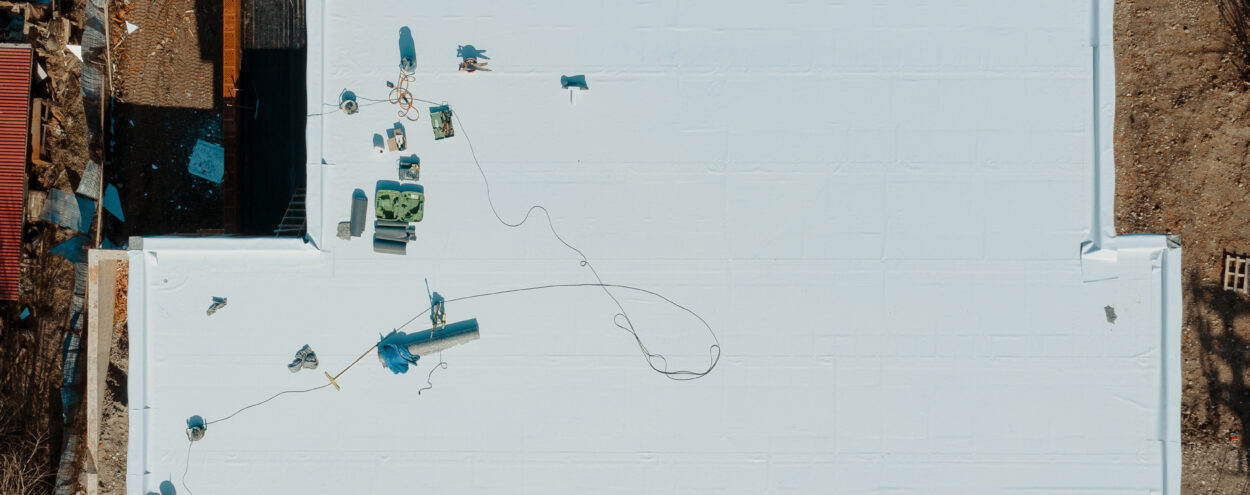Watkins Construction & Roofing presents the top types of flat roofs. Flat roofs help you obtain a contemporary and clean style. No one can ignore the evident benefits they provide.
Are you looking to install a flat roof in your home or business? What follows is a comprehensive guide to the many kinds of flat roofs available.
Flat roofs come in three main varieties:
- BUR or “Built-up roofing”
- Modified Bitumen Roofing
- Single-ply Membrane
There are three main types of single-ply membrane roofs: PVC, TPO, and EPDM.
Find out more about various kinds of flat roofing for homes.
Built-Up Roofing or BUR
The BUR-style tar and gravel roof is perhaps the oldest and most common form of flat roof. Several types of flat roofs are making BURs less common on homes. However, BURs are still the most popular choice for commercial structures.
Hot asphalt is sprayed on top of roofing felt in this style of roof. Typically, BURs have 3 to 5 layers. Each additional layer extends a few years the longevity of the roof. Besides, homeowners benefit from improved insulation and UV protection in one package with multi-layer BUR. These also improve the energy efficiency of houses.
- The price per square foot goes from $2.5 to $4.
- BURs are robust and you can choose the number of layers you want.
- The uppermost layer provides adequate UV protection, besides protecting the underlayers.
- Thermal control and energy efficiency are two of the primary benefits of this style of roof.
The BURs disadvantage is that they need a lot of time and effort to install. Also, toxic scents are released throughout their installation.
Modified Bitumen Roofing (MBR)
The practice of laying many layers is each time less frequent. Instead, we now make use of MBR. In the MBR process, there is only a single player or ply. Fiberglass or polyester might be added to the polymer-modified asphalt to strengthen the bitumen further.
Installing MBR is a reasonably simple process, and even you may do it on your own. To achieve a proper seal, certain MBRs need the use of torches to melt the material. Also, there is a peel-and-stick application.
- Installation costs between $4 and $8 per square foot. Contractors may do it for as little as $3 to $7.
- Installing MBR is a breeze because of its adhesive alternatives.
- These roofs have excellent reflectivity and there is a variety of colors to pick from.
The lack of durability, and therefore, the lifespan, is one of the drawbacks. An MBR may endure for 10-20 years with proper care. It doesn’t take long for blown debris, human footsteps, and natural forces to damage these types of roofs.
Single-ply Membrane (SPM)
SPM roofs are made of a single layer of material applied to a substrate. These have a much longer lifespan and function better. SPM roofs are available in PVC, EPDM, and TPO.
These have a much longer lifespan and function better. SPM roofs are available in PVC, EPDM, and TPO.
Single-ply PVC membrane roofing.
- PVC roofs are $8-$12 sq. foot
- PVC roofs require less care and last far longer than conventional roofs.
- Color possibilities abound. You can even go patterned!
- PCV roofs reflect a lot of sun.
Because PVC is a material, it can shrink with time, causing leaks or corner artifacts. A cold snap can break or penetrate ancient PVC roofs.
Single-ply TPO (thermoplastic polyolefin) roofing
- TPO roofs are $5-$6 sq. foot
- Its flexibility allows it to cover uneven roof cuts and forms, as well as travel over and around obstacles.
- These roofs are cheap, reflective, and recyclable.
- TPO roofs eliminate mold, algae, dirt, corrosion, and mildew growth.
Extreme heat can create fractures or broken seams in TPO roofing. It has a 10–20-year lifetime.
Single-ply EPDM (Ethylene Propylene Diene Monomer) roofing
- EPDM roofing range from $6 to $13 per square foot
- EPDM roofs commonly replace BUR roofs. Choose from black or white, reinforced, or unreinforced.
- They are UV resistant and reflect.
- EPDM roofing is straightforward to install.
- Elastomer is resistant to heat and fire.
Certain chemicals and oils can cause EPDM roofs to bulge. Water can delaminate reinforced EPDM roofs to bulge. Water can delaminate reinforced EPDM sheets.
Finishing
Have you picked the ideal flat roof? Then you may be interested in Spray Polyurethane Foam. It is a liquid applied roof treatment that seals every crack and nook.
This spray may be used on metal, roof decks, substrates, or even shingles.
Help? A contractor can help you establish a building plan for your next home renovation.
Watkins Construction & Roofing is an award-winning roofing business that specializes in roof repairs and replacements.
For more information and, contact Watkins Construction & Roofing at 601-488-3179. We service areas in Jackson, MS, Ridgeland, MS, and Flowood, MS.
